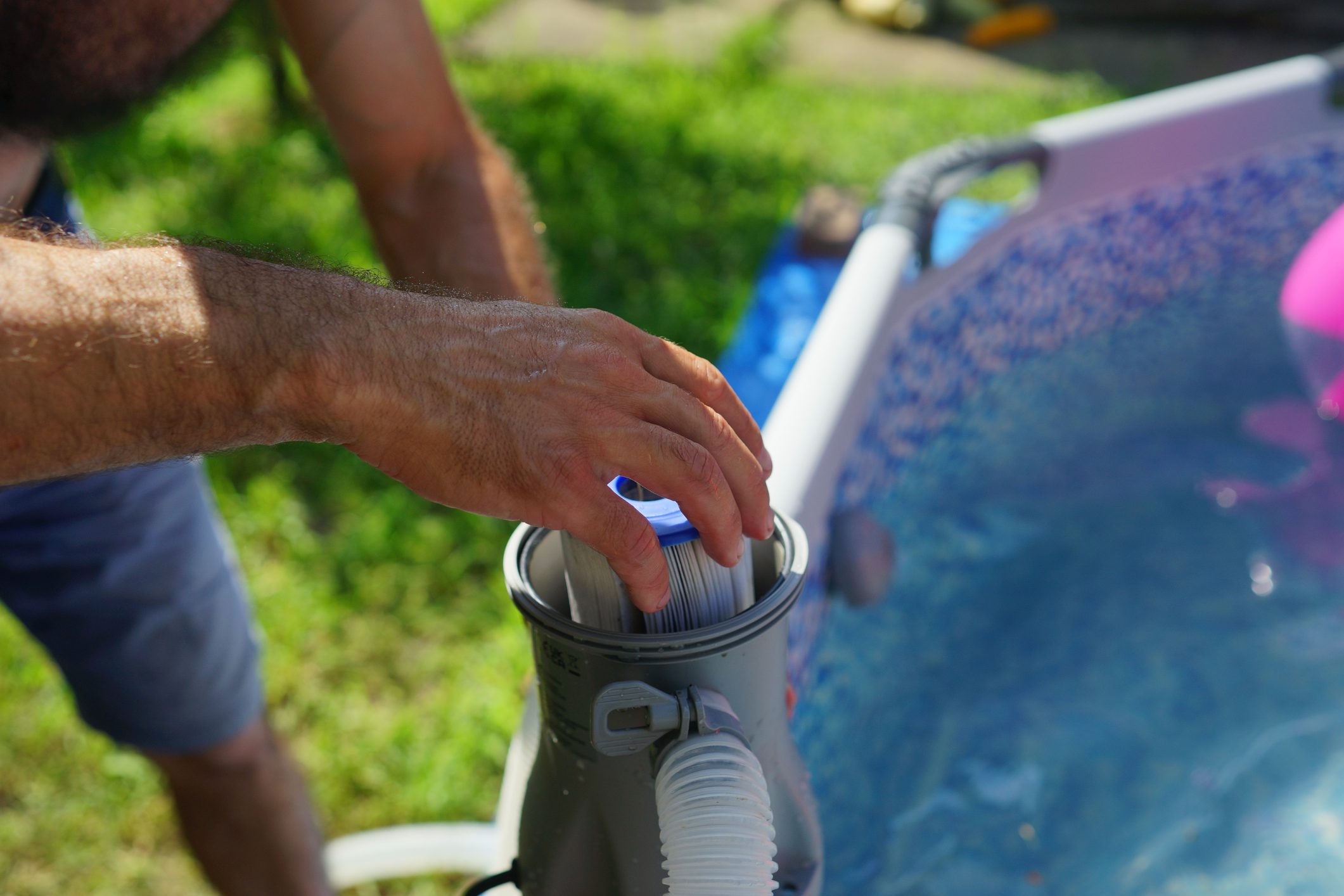Swimming pool filters are not one size fits all. Here's a look at the different types and which one might be best for your pool.

What You Need To Know About Pool Filters

If you’re thinking of adding a swimming pool to your backyard, you’ll quickly discover there are three main types of pool filters. They’re not interchangeable; each operates differently, and with different equipment.
When you shop around for a pool contractor, each professional is likely to present their preferred filter system. So as a consumer, knowing your options will help you make the best choice.
Family Handyman contacted Brian Wells, an expert at Leslie’s Pools, who described the most common types of pool filters — DE, sand, and cartridge — and the pros and cons of each.
On This Page
DE Pool Filters
DE stands for diatomaceous earth. It’s a naturally occurring sedimentary rock that crumbles easily into a powdered form capable of filtering water, Wells says. DE pool filters contain DE powder that adheres to grids within the filter tank to capture debris.
“Some pool owners and pros prefer DE filters because they filter out the smallest particles, and it’s easy to replace the DE powder within the filter after every backwash cycle,” Wells says.
DE filters are most often found in in-ground pools, he says, but that there are models for above-ground pools as well. Upfront costs are higher with DE filters. But, Wells says, “They make up for it in their ability to provide better filtration.”
Sand Pool Filters
This option features a large tank filled with sand. “Water from the pool enters the tank,” Wells says. “The pool pump pushes the water through the sand inside, and the water is filtered and cleaned before it returns to the pool.”
Wells says some pool owners and professionals prefer sand filters for a few reasons. “They are relatively durable, easy to operate, and fairly low maintenance,” he says. “The filter sand only needs to be replaced every three to five years, or can sometimes last even longer with good care and proper cleaning.”
Wells adds that compared to other filter systems, sand filters are the cheapest to purchase. But because they may not offer the same level of filtration as a DE or cartridge filter, he often suggests adding an alternate filter media type or clarifier.
P.S. Knowing the best pool shock treatments to clean your pool will come in handy.
Cartridge Pool Filters
These involve one or more cylindrical filters made of pleated paper-like material. The filter(s) sits in a tank, and water flows through the filter before cycling back into the pool.
“Although cartridge filters tend to be narrower [than other filter types],” says Wells, “the long rows of pleats allow the water to filter over a larger surface area, which can put less strain on the pool pump.”
Wells says cartridge filters are popular because “they’re the most energy-efficient option, they’re simple to replace, they help conserve water without the need to backwash, and they work great for in-ground and above-ground pools.”
Comparing filtration ability and costs, Wells says “cartridge filters land between sand filters and DE filters, which is a nice middle ground that meets the needs of most pool owners.”
Cleaning Pool Filters
Regardless of which filter you go with, all need routine cleaning and maintenance. Here’s how to do it for each system.
Even if you plan to do regular cleaning yourself, we strongly recommend asking a pool pro to walk you through the steps. Ideally the pool tech can provide a video or written tutorial, or you can take detailed notes.
Cleaning DE pool filters
DE filters provide superior filtration, and their routine cleaning is slightly more complicated than sand or cartridges filters. They’ll need basic cleaning about once a month, and deeper cleaning prior to winterization.
The basic cleaning steps are:
- Run the pool through a backwash cycle, which flushes the filter of accumulated debris, including larger stuff like leaves.
- Remove the manifold and the cloth-like DE grids and hose them off.
- Mix new DE solution and add it to the filter.
Cleaning sand pool filters
Routine cleaning essentially involves running a backwash cycle. Unlike DE filters, which need to be replenished with every backwashing, filter sand only needs to be replaced every few years.
Cleaning cartridge pool filters
Unlike DE and sand filters, cartridge pool filters don’t need backwashing, just periodic removal and cleaning. Here’s a complete guide for how to clean cartridge pool filters, including as part of pool winterization. But essentially, routine cleaning means removing the filters and rinsing them thoroughly with a hose.
How Long Do Pool Filters Last?
Wells provided the average lifespan of DE, sand and cartridge pool filters. Here’s what you can expect:
DE filter grids: The cloth-like inserts that contain DE typically last three to four years before they need replaced. But the DE powder must be replenished after each backwash.
Sand pool filters: The sand will need replaced every three to five years. Wells recommends occasionally using a cleaning solution for filter sand, which he says will help remove oil and mineral buildup. When it’s time to replace the sand, he recommends a Zeolite sand filter media, which he says “can provide up to 90% more efficient filtration than sand alone, rivaling the efficiency of diatomaceous earth.” Zeolite costs more than normal pool filter sand but also lasts longer, about four to six years on average.
Filter cartridges: Replace these every two to three years, or sooner if you notice tears or other damage during routine cleaning. Ensure the life of your cartridges by periodically soaking them in a cartridge cleaning solution.




















